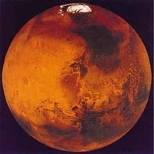On Aug. 27, Mars will be closer to Earth than it has been in nearly 60,000 years. But 35 million or 37 million miles away--what's a few million miles among friends?
Robert B. Phillips, a research scientist at MIT's Haystack Observatory, said he's not sure what all the media fuss is about. "Mars makes close approaches every 15 or 17 years. The 1971 approach was trivially different from this one," he pointed out. But that hasn't stopped him from enjoying the latest view of Mars, which he did last week in central Maine.
"We stood on an east-facing dock over the water near Lincoln, Maine," he said. "Even when we first picked it up (with a portable 8-inch telescope), it knocked you flat. We saw the polar cap. We played with colored filters, because some brought out the polar cap better. We even saw some clouds at the day-night boundary."
If you don't own a telescope, the Museum of Science and local astronomy departments are offering free viewings and public lectures. Or just look--the Red Planet will be visible and characteristically reddish to the naked eye. Don't be fooled by a nearby red supergiant star called Antares ("rival of Mars.")
"What's equally important to Mars' distance is the fact that the sun, Earth and Mars are in a line. Mars rises around the time the sun sets, which makes it convenient for normal folks to see it," Phillips said.
In greater Boston, the problem is our cluttered horizon. While Australians get an unobstructed view, for us, Mars rises in the southeast, sort of scuds along in the southern sky and never gets higher than around 30 degrees above the horizon. Suburbanites might have better luck, with a darker sky and better eastern horizon.
Phillips recommends checking the Heavens-Above web site for Mars' rising times. The site also tracks the position of the International Space Station, so you can also impress your friends and relatives by glancing up and saying, "Isn't the space station due right around now?" and having it appear on cue.
Another interactive space activity is suggesting places on Mars that should be photographed. Camera operators for NASA's Mars Global Surveyor spacecraft are taking suggestions online for new places to be photographed by the Mars Orbiter Camera. Information about how to submit requests is available at the Mars Orbiter Camera Target Request Site. An online gallery of pictures taken by the high-resolution camera, some of which show features as small as a school bus, are at Mars Global Surveyor Mars Orbiter Camera Image Gallery .
The Mars Global Surveyor, managed by NASA's Jet Propulsion Laboratory, has been orbiting Mars since 1997 and has taken 120,000 pictures so far, covering around 3 percent of the planet.






